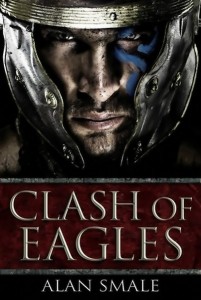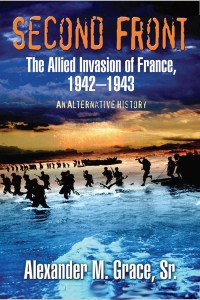I received this book for free from Del Rey in exchange for an honest review. This does not affect my opinion of the book or the content of my review.
 A Clash of Eagles by Alan Smale
A Clash of Eagles by Alan Smale Published by Del Rey, Titan Books on 20 March 2015
Genres: Type III - Soft, Type IV - Utterly Implausible
Pages: 416
Format: eBook
Source: Del Rey
Buy on Amazon
Goodreads

Premise - Point of Divergence (POD)
In 211 AD Geta survives an assassination attempt by his older brother, and co-Emperor Caracalla. Geta wins the following decade long civil war and introduces a number of civil reforms designed to limit his own powers and those of his successors. Military reforms also deter individual legions from aligning themselves with pretenders to the Imperial throne allowing the Roman Empire to continue to flourish, and to successfully weather the subsequent barbarian invasions.
The Story
The Roman Empire never fell. Now, in 1218 AD, jaded commander Gaius Marcellinus leads his legion into North America confident that he will find easy victories and the gold necessary to finance his Emperor’s endless wars with Mongol China.
Marcellinus couldn’t be more wrong. The inhabitants of Nova Hesperia have impressive fighting skills, along with sophisticated flying machines constructed of wood, skin and sinew which decimate even his disciplined legionaries. And after a harrowing march into the middle of the vast continent, Marcellinus will face the full might of the Mississippian mound-builder culture in a battle that will change his life forever….
The Review
I will start by saying that I thoroughly enjoyed the book, and that if I hadn’t its significant failings wouldn’t have been so important. But the author has told a damn good story, with believable, likeable characters. I am aware that other reviewers are complained that there is too much focus Marcellinus, with other characters remaining undeveloped. But I must beg to differ here. Certainly Marcellinus serves as the focus of the plot, but other characters were developed sufficiently for you to understand their needs and desires. As Marcellinus learnt about them, so did the readers.
As an ‘alternate’ history, however, this rates well up there with Harry Turtledove, and not in a good way. I mean, flying machines, and a Roman Army with a technology that hasn’t progressed in over 1,000 years. I mean, pleeese!
What I couldn’t decide is whether the author’s world he designed was so utterly implausible by accident, or whether he deliberately designed the story to be a work of fiction. In the end, given the number of references on the Roman Army he quoted I had to plump on the side that he deliberately designed it as a fantasy. In short, this is a conceit (defn. a fanciful thought, idea, or expression, especially of a strained or far-fetched nature). Admittedly a very well written and entertaining conceit, but if you intend reading it you need to be aware of this.
The army as described by the author appears to closely represent the Roman Army of the 1st century. But the book takes place 1218, over 1,000 years after the Point of Dviergence (POD). More importantly many of the technologies used by Marcellinus’s soldier had already changed by the POD. Take for example the pugio, a dagger used by Marcellinus and other Roman soldiers – the problem is that there is no archeological or artistic evidence of the pugio past the 3rd century. And then there’s the shields. By the third century the familiar convex, rectangular shield were already being replaced by a simple oval or round shield. And then the pila. Macellinus’ soldiers still used the pila yet by the POD Roman soldiers had replaced these with half a dozen lead-weighted throwing darts, which incidentally would have proved very useful against the native Americans.
The biggest failure, however, is Rome’s exclusive use of foot soldiers. OK, so there are contrary views concerning whether the Roman Army was actually making greater use of cavalry during the 4th century (the traditional view). But Marcellinus’ Roman Empire is now involved in an endless series of wars with Mongol China, which would have required a heavy use of cavalry. And it’s not impossible to transport horses across the Atlantic (as witnessed by the fact that Marcellinus did have his own personal mount). In support of the expectation that the legion should have included at least a number of light cavalry Spain had established sufficient horses in the Caribbean within 27 years of Colombus’ first voyage, to permit Cortez to include 15 horses with his expedition against the Aztecs.
So am I going to purchase the sequel? Yes – I like Marcellinus and I want to see him achieve his dream – but it doesn’t get a five from me.

 Second Front: The Allied Invasion of Europe 1942-43 by
Second Front: The Allied Invasion of Europe 1942-43 by